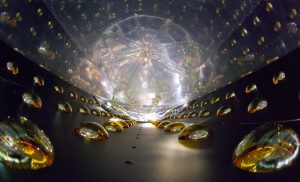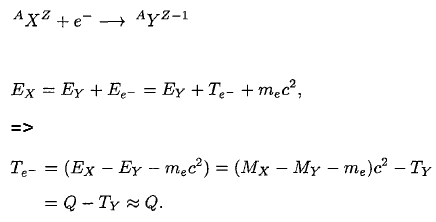Carrying no electric charge they are not affected by electromagnetic forces that act on another charged leptons, such as electrons. Since neutrinos belong to the family of leptons, they are not subject to the strong force. Neutrinos are subject to the weak force, which is of much shorter range than electromagnetic force and gravity force. Therefore, neutrinos are the most penetrating subatomic particles, capable of passing through Earth without any interaction. It is estimated neutrinos have interaction cross-sections about 20 orders of magnitude less than typical cross-sections of scattering of two nucleons (~10-47m2 = 10-19barn). It is estimated neutrino cross-section for interaction increases linearly with energy of incident neutrino.
Reference: Griffiths, David, Introduction to Elementary Particles, Wiley, 1987.
See also: Antineutrino
 Source: wikipedia.org
Source: wikipedia.org The inside of a cylindrical antineutrino detector before being filled with clear liquid scintillator, which reveals antineutrino interactions by the very faint flashes of light they emit. Sensitive photomultiplier tubes line the detector walls, ready to amplify and record the telltale flashes.
The inside of a cylindrical antineutrino detector before being filled with clear liquid scintillator, which reveals antineutrino interactions by the very faint flashes of light they emit. Sensitive photomultiplier tubes line the detector walls, ready to amplify and record the telltale flashes.Photo: Roy Kaltschmidt, LBNL
Source: Daya Bay Reactor Neutrino Experiment
Production of Neutrinos
Neutrinos can be produced in several ways. The most powerful source of neutrinos in the solar system is doubtless the Sun itself. Billions of solar neutrinos per second pass (mostly without any interaction) through every square centimeter (~6 x 1010 cm-2s-1) on the Earth’s surface. In the Sun, neutrinos are produced after fusion reaction of two protons during positive beta decay of helium-2 nucleus.
Each nuclear reactor is also very powerful source of neutrinos. In fact, antineutrinos. In a nuclear reactor occurs especially the β− decay, because the common feature of the fission products is an excess of neutrons (see Nuclear Stability). An unstable fission fragment with the excess of neutrons undergoes β− decay, where the neutron is converted into a proton, an electron, and an electron antineutrino.
Reference: Griffiths, David, Introduction to Elementary Particles, Wiley, 1987.
We hope, this article, Neutrino, helps you. If so, give us a like in the sidebar. Main purpose of this website is to help the public to learn some interesting and important information about radiation and dosimeters.

